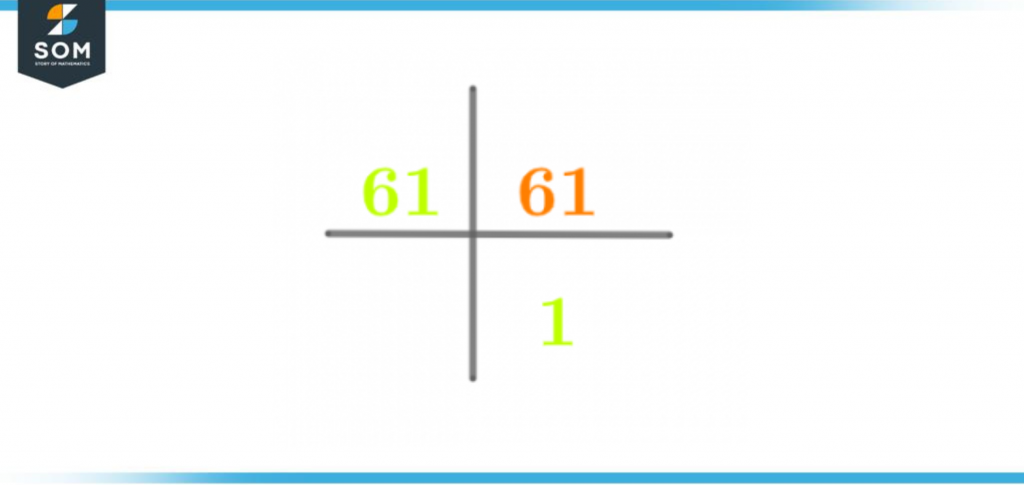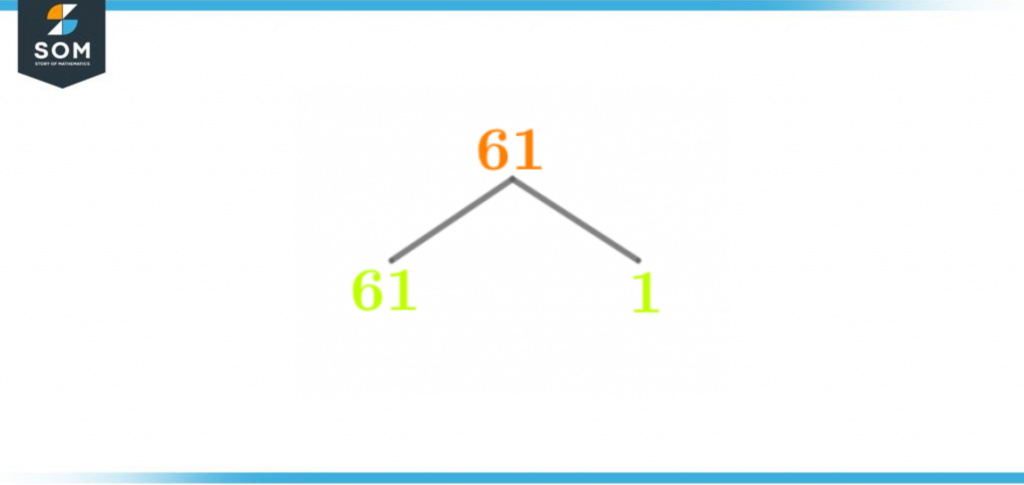JUMP TO TOPIC
Factors of 61: Prime Factorization, Methods, Tree, and Examples
The factors of 61 are the numbers that generate 61 as the product when they are multiplied by each other. Such two numbers, which result in 61 after multiplication, form a factor pair of the number 61.
Figure 1 – All possible Factors of 61
What Are the Factors of 61?
The factors of 61 are 1 and 61. The number 61 has a total of 2 factors, and these two factors can join together to form a single factor.These factors of 61 can exist as positive and negative integers. Since the number 61 is a prime number, the factors it has are also prime numbers. In mathematical terms, the number 61 can be defined on the basis of division as well. In the division realm, the factors of 61 are defined as the numbers that result in a whole number quotient and a zero remainder when 61 acts as the dividend for them.How To Calculate the Factors of 61?
You can calculate the factors of any number by using the division method. The factors of 61 can also be determined through the division method.The condition of the division method is that if a zero remainder and a whole number quotient are produced, then the number as the divisor is qualified to be a factor of the number acting as the dividend. The number 61 is a prime number, and we know that a prime number has only two possible factors, so that we will apply the division method to these possible factors of 61.The division method applied on the number 61 is shown below:\[ \frac{61}{1} = 61 \]As a result of this division, a whole number quotient is produced, and a zero is obtained as the remainder, indicating that the number acting as the divisor is a factor of 61, in this case, the number 1.Apart from the smallest factor, 1, the number itself also acts as the factor of 61. So keeping this viewpoint in mind, let’s move on to the division of 61 by 61 itself. This division is shown below:\[ \frac{61}{61} = 1 \]Again we observe that the condition for the factor has been satisfied in the second division step. Hence, it is proven that 61 is also a factor in itself.So, to summarize, the factors of 61 are written below:Factors of 61: 1 and 61There is no limit that these factors only have to be positive. These factors can also exist in the form of negative numbers. The negative factors are the same as positive factors, but their signs are reversed.The negative factors of 61 are given below:Negative Factors of 61: -1 and -61Factors of 61 by Prime Factorization
The prime factorization method is based on the mathematical operation of division. This method states that a number keeps undergoing division with the help of prime numbers until only the number 1 is left at the end.The condition of prime factorization is that only prime numbers can act as divisors. The prime factorization of the number 61 is shown below:61 $\div$ 61 = 1
Prime Factorization = 1 x 61
This prime factorization is also shown below in Figure 2:
Figure 2 – Prime Factorization of 61
Factor Tree of 61
The factor tree of 61 has a structure similar to a tree in which branches originate from a number. These branches hold the number, among which one is a prime number and the other is the number that continues the division process.The last branches of the factor tree will always hold prime numbers.The factor tree for the number 61 is shown below:
Figure 3 – Factor Tree of 61
Factors of 61 in Pairs
The factors of 61 can also exist in the form of pairs which are known as factor pairs. A factor pair consists of two numbers that are capable of producing the original number as the result when they are multiplied together.Since the number 61 is a prime number with only two factors, these two factors can form a single factor pair. This factor pair is given below:1 x 61 = 61
Factor Pair of 61 = (1, 61)As factors of 61 are negative as well, these negative numbers can form negative factor pairs. This negative factor pair is given below:-1 x -61 = 61
Negative Factor Pair = (-1, -61)Total Numbers of Factors of 61
The total number of factors of 61 can be determined through a technique known as factorization. According to this technique, a number’s prime factors are listed down, along with the number 1.After listing these factors, one is added to their current exponents, and later on, all these exponents are multiplied. The resulting number gives the total number of factors, inclusive of both positive and negative factors.This process is shown below:Factorization of 61 = 1 x 61
Since these factors have 1 as their exponents, adding 1 to them and multiplying them together gives four, which is the total number of factors of 61.These total factors of 61 are given below:Total Number of Factors of 61 = 1, -1, 61, and -61Similarly, the total number of factor pairs of 61 is given below:Total Number of Factor Pairs = (1, 61) and (-1, -61)Some interesting facts about the number 61 are given below:- The number 61 is the 18th prime number in the series of prime numbers.
- The sum of the factors of the number 61 is an even number: 1 + 61 = 62.
- The sum of the digits of the number 61 is an odd number: 1 + 6 = 7.
- The number 61 is an odd prime number.
Factors of 61 Solved Examples
That’s all there is to know about the factors of 61. To learn more about these factors, let’s consider some examples given below.Example 1
Calculate the average of the factors of 61 and determine if it is a multiple of 2.Solution
To determine the average of the factors of 61, let’s first list these factors down. The factors of 61 are given below:Factors of 61 = 1 and 61Now, let’s look at the formula of the average. This formula is given below:\[ Average = \frac{\text{Sum of factors of 61}}{\text{Total number of factors of 61}} \]\[ Average = \frac{ 1 + 61}{2} \]\[ Average = \frac{62}{2} \]Average = 31
Hence, the average of all the factors of 61 is 31.The number obtained after calculating the average of the factors of 61 is an odd number, indicating that the number 31 is not a multiple of 2.Example 2
Calculate the sum of the digits 61 and the factors of 61 and determine the difference between them.Solution
First of all, let’s list down the factors of 61:Factors of 61 = 1 and 61Now, let’s calculate the sum of the factors of 61. Calculating their sum below:Sum of the factors of 61 = 1 + 61
Sum of the factors of 61 = 62
Now, let’s calculate the sum of the digit of 61. The sum of the digit of 61 is given below:Sum of digits of 61 = 1 + 6
Sum of digits of 61 = 7
Now, let’s calculate the difference between these two quantities.The difference is given below:Difference = Sum of factors of 61 – Sum of digits of 61
Difference = 62 – 7
Difference = 55
All images/mathematical drawings are created with GeoGebra.